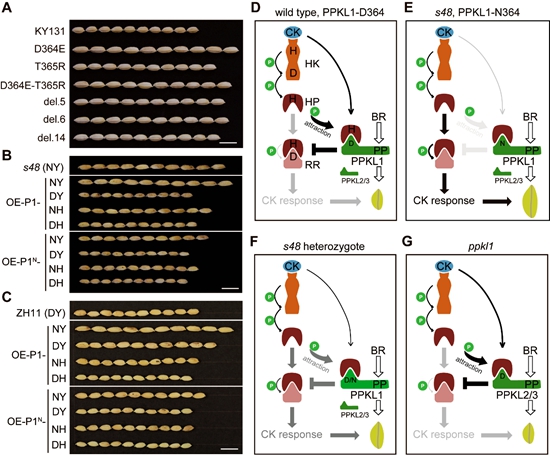Scientists from ICS Discover the Control Mechanism on Plant Hormone Cytokinins
Cytokinins are classical, historic plant hormones regulating diverse aspects of plant growth and development, including the important agronomic traits such as grain number in rice. The canonical signal transduction process of cytokinins is well-known as phosphorelay process, which means the transfer of the phosphoryl group among different proteins including HKs, HPs and RRs. However, how this process is controlled by plant cells and whether the hormones regulate grain size in rice remain largely unclear.
Recently, researchers from the Institute of Crop Sciences of the Chinese Academy of Agricultural Sciences (ICS-CAAS) have reported a new cytokinin signaling component named PPKL1, which plays a part via seducing the phosphoryl group to interfere with the hormonal signaling thus suppress grain size in rice. The discoveries were online published in Molecular Plant, a leading international plant science journal.
The study showed that a specific amino acid D364 of PPKL1 is the most important for the protein function. D364 resides in a region resembling the receiver domain of RRs, and likes RRs, PPKL1 can interact with OsAHP2, one of authentic HPs. Accordingly, PPKL1 can utilize D364 to suppress OsAHP2-to-RRs phosphorelay, whereas mutation of D364 abolishes the effect therefore activates cytokinin response and enlarges grain size. PPKL1 was previously known as a signaling component of steroid hormone brassinosteroid. This study revealed that it is actually a cryptic inhibitor of cytokinin phosphorelay, and this function is independent of the phosphatase domain that should be required for brassinosteroid signaling. Importantly, editing on the D364-residential region produces a diversity of semi-dominant mutations associated with variously increased grain sizes. The screening enables the identification of two genotypes conferring which significantly improved crop yield.
According to Professor Tong Hongning who is the team’s chief scientist, to meet the growing food demand due to an increasing in population, intense efforts are being made to understand how cellular growth is regulated in cereal grains which is the staple food source. This study reveals not only a noncanonical cytokinin signaling suppressor but also a robust tool for seed rational design, thus makes a significant advance in both basic and applied researches.

Molecular design of rice grain size via manipulation of the cytokinin signaling controller PPKL1
By Tong Hongning (tonghongning@caas.cn)
-
 Apr 18, 2024Opening Ceremony of the Training Workshop on Wheat Head Scab Resistance Breeding and Pest Control in Africa Held in CAAS
Apr 18, 2024Opening Ceremony of the Training Workshop on Wheat Head Scab Resistance Breeding and Pest Control in Africa Held in CAAS -
 Apr 03, 2024IPPCAAS Co-organized the Training Workshop on Management and Application of Biopesticides in Nepal
Apr 03, 2024IPPCAAS Co-organized the Training Workshop on Management and Application of Biopesticides in Nepal -
 Mar 28, 2024Delegation from the School of Agriculture and Food Science of University College Dublin, Ireland Visit to IAS, CAAS
Mar 28, 2024Delegation from the School of Agriculture and Food Science of University College Dublin, Ireland Visit to IAS, CAAS -
 Mar 25, 2024Director of World Food Prize Foundation visited GSCAAS
Mar 25, 2024Director of World Food Prize Foundation visited GSCAAS -
 Mar 20, 2024Institute of Crop Sciences (ICS) and Syngenta Group Global Seeds Advance Collaborative Research in the Seed Industry
Mar 20, 2024Institute of Crop Sciences (ICS) and Syngenta Group Global Seeds Advance Collaborative Research in the Seed Industry
